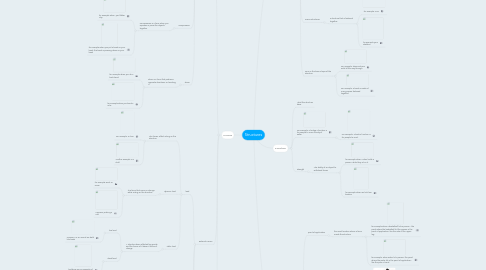
1. Forces
1.1. Internal Forces
1.1.1. A force that acts on an object on the inside
1.1.1.1. For example, a person pressing down on a table
1.1.1.2. Another example is when someone bend a book
1.1.2. Tension
1.1.2.1. Tension is a stretching force
1.1.2.1.1. for example when you stretch a rubber band so it expands
1.1.2.1.2. for example when you stretch your body
1.1.3. Torsion
1.1.3.1. Torsion is a twisting force
1.1.3.1.1. for example when you twist or turn your body around
1.1.3.1.2. for example when you twist clay
1.1.4. Compression
1.1.4.1. Compression is a force when you squeeze or press the objects together
1.1.4.1.1. for example when you flatten clay
1.1.4.1.2. for example when you put a book on your head, the book is pressing down on your head
1.1.5. Shear
1.1.5.1. shear is a force that pushes in opposite directions, or bending it
1.1.5.1.1. for example when you do a back bend
1.1.5.1.2. for example when you bend a ruler
1.2. External Forces
1.2.1. load
1.2.1.1. The forces' effect acting on the structure
1.2.1.1.1. For example, a chair
1.2.1.1.2. Another example is a child
1.2.1.2. dynamic load
1.2.1.2.1. The force that move or change while acting on the structure
1.2.1.3. static load
1.2.1.3.1. A structure been effected by gravity, and the forces of it doesn't move or change
1.2.2. gravity
1.2.2.1. The natural force of attraction between two objects
1.2.2.1.1. For example, when you bounce a ball, the ball will be pulled down by gravity.
1.2.2.1.2. For example, when a person jump, he or she will always be pulled down by gravity.
1.2.3. A force that acts on an object from the outside
1.2.3.1. For example, an earthquake.
1.2.3.2. For example, rainfall, glaciers, etc.
1.3. Any push or pull that acts on structures
1.3.1. For example, a cat pulling a ball
1.3.2. For example, a person pushing against a desk.
2. Types of structures/form
2.1. Combination Sturctures
2.1.1. A structure that is made up of all the other structures combined.
2.1.1.1. for example a house
2.1.1.2. for example a bed
2.2. Shell Structures
2.2.1. a strong hollow structure that can contain things inside
2.2.1.1. for example a water bottle
2.2.1.2. for example an igloo
2.3. Solid Structures
2.3.1. a structure that is solid all the way through
2.3.1.1. for example a sand castle
2.3.1.2. for example a rock
2.4. Frame Structures
2.4.1. a structure that is fastened together
2.4.1.1. for example a car
2.4.1.2. for example your skeleton
2.5. Form is the basic shape of the structure
2.5.1. For example, diamonds are solid all the way through.
2.5.2. For example, a book is made of many papers fastened together.
3. Function
3.1. What the structure does.
3.2. For example, a bridge's function is for people to cross a body of water
3.2.1. For example, a book's function is for people to read.
3.3. strength
3.3.1. The ability of an object to withstand forces
3.3.1.1. for example when a chair holds a person, while they sit on it
3.3.1.2. for example when we hold our binders
4. Describing forces
4.1. point of application
4.1.1. the exact location where a force meets the structure
4.1.1.1. for example when a basketball hits a person , the point where the basketball hit the person is the point of application, like the side of the upper leg.
4.1.1.2. for example, when water hit a person, the point where the water hit is the point of application, like the palm a hand.
4.2. plane of application
4.2.1. the side of a structure that's been effected by force.
4.2.1.1. for example, a ball that's been hit with 90 degrees
4.2.1.2. for example, a golf ball been hit with 180 degrees angle
4.3. direction
4.3.1. Which direction the force meet the structure: a push or a pull
4.3.1.1. for example a person pushing a cart
4.3.1.2. for example, a person pulling a rope.
4.4. magnitude
4.4.1. How strong or weak the force is.
4.4.1.1. for example, gently tap a table, and the table is not been effected, the magnitude is low.
4.4.1.2. For example, pushing a desk really hard, the desk moved over, the magnitude is high.

